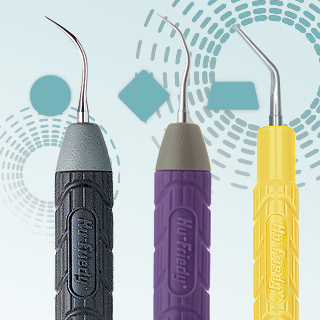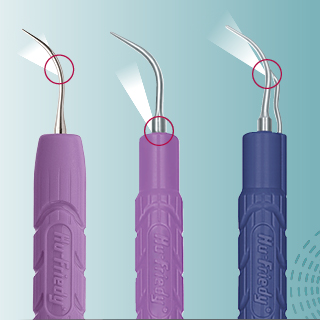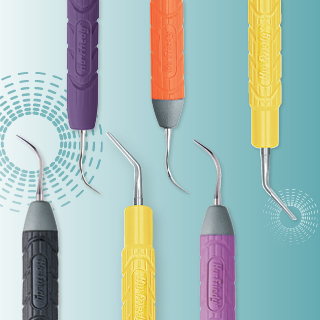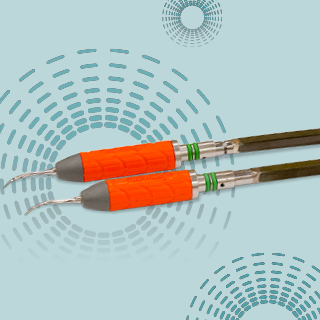Blog
Four Factors for Selecting Ultrasonic Inserts

Learn How to Make the Right Choices for Efficient and Effective Ultrasonic Scaling
When it comes to selecting the right ultrasonic inserts for clinical procedures, one size does not fit all. There are many varieties of handle and tip designs to choose from, and the “right” insert can change from patient to patient. Since you may have an ultrasonic insert in your hand for over two hours per day, various factors can help you maximize ultrasonic technology for optimal clinical outcomes.
Here are a few important factors to consider:
Tip Geometry

Ultrasonic insert tips come in a variety of diameters, lengths, shapes and cross-sections. Just as there is no single “universal” scaler there is no single “universal” ultrasonic insert that can be used in all locations at all times. Deposit type, location and tenacity, pocket topography, tooth anatomy, and gingival conditions are all considerations when selecting an ultrasonic insert. Again, just like scalers, selection of appropriate inserts results in more effective and efficient deposit removal. Tip geometry is an important, but often overlooked, consideration when selecting inserts for your clinical procedures.
Some ultrasonic inserts, including Hu-Friedy’s #1000 Triple Bend and XT Triple Bend, are designed with “edges” – or bevels – on the tip. These bevels concentrate the ultrasonic energy, resulting in additional power along that edge. Tips with an edge rely on this concentrated energy to create micro-fractures in the calculus, resulting in more efficient removal of even the most tenacious deposits.
Tips that are round in cross-section, such as Hu-Friedy’s #10 Universal or #100 Thin, allow energy to spread more equally around the tip surface and are better suited for light to moderate deposits, new calculus, and biofilm removal since those deposits can be removed without the power boost provided by an edge or bevel.
Ultimately, the first step to finding the right insert is understanding the types of procedures that will be performed and choosing accordingly from many available tip designs.
Water Delivery Method

Water is a critical element of any ultrasonic tip, operating as a coolant to prevent the handpiece from overheating and acting as a lavage to flush debris from the treatment site. As insert design has progressed over the years, you now have a choice of water delivery options.
In the original design, water was delivered through an external tube running parallel to the tip, positioning water flow over the tip to the treatment site. However, these inserts require delicate handling as any bending or misalignment of the external water tube causes the water flow to be misdirected. A reengineered design eliminated the external tube and allowed water to flow through the grip and exit at the base of the tip.
As ultrasonic technology and design continued to advance, water delivery methods were modified again – resulting in the ability to have the water flow through the grip and through the tip, exiting very close to the working end of the insert. This Direct Flow™ water delivery method minimizes excess spray, thus improving visibility to the treatment site, and is the preferred water flow delivery method for most clinicians today.
All three water delivery styles remain available from Hu-Friedy. Since each allows for effective tip cooling and lavage of the treatment site, selection is a matter of personal preference.
Handle Style

With an insert in your hand for upwards of two hours per day, ergonomic and style preference is critical to minimizing hand fatigue and pressure points, providing more comfort for your clinical routine. Hu-Friedy offers several insert handle options that vary in diameter and offer different features for you to select from:
- Swivel and Swivel Direct Flow™ – Have you noticed the “start, stop, reposition” routine required with traditional inserts? Tooth surfaces are accessed multiple times during ultrasonic scaling procedures as light, overlapping strokes result in thorough debris removal. With a slight rolling motion of your fingertips the handle and tip of a Swivel insert will rotate 360° allowing for smooth and efficient power scaling.
Swivel assists by providing:- Easy tip adaptation to tooth surfaces
- A greater range of scaling access before needing to readjust your fulcrum
- Movement from buccal/lingual to interproximal surfaces without removing the tip from the pocket
- Efficiency around intricate tooth surfaces, including line angles, furcations, and concavities/convexities.
- Streamline™ PLUS – New in 2019, these inserts feature the same comfortable textured silicone grip as the top-selling Swivel inserts without the rotating functionality. The wider grip – 18% larger than Streamline Classic inserts – helps reduce finger pinching and hand fatigue while increasing tactile sensitivity. Additionally, the tapered cone positioned between the grip and shank provides an unobstructed view of the treatment site.
- Streamline Direct Flow – A lightly textured wide diameter resin grip assists in maintaining a secure grasp and superior tip control, supporting clinician comfort by reducing finger pinching.
- Streamline Classic – The original, lightly textured grip is ideal for those who prefer a smaller diameter handle.
Hu-Friedy offers these four insert handles to allow you to choose the best option for you, your equipment, and practice. Take the time to evaluate your preferences and what you need to stay in peak condition long term.
Frequency

Magnetostrictive generators are typically designed to operate at frequencies of 25 kHz or 30 kHz. This means the generator will cause the inert tip to vibrate either 25,000 times per second or 30,000 times per second. Some generators, such as Swerv™, can accommodate both 25 kHz and 30 kHz inserts with a simple change of the handpiece.
Power setting changes on the device itself do not change the number of vibrations per second, and either 25 kHz or 30 kHz inserts will function well to remove debris. By far, the most popular insert frequency used today is 30 kHz. For optimal scaling performance, it is critical that the frequency of the inserts match that provided by the generator. Hu-Friedy offers a wide selection of both 25 kHz and 30 kHz inserts, so be sure to doublecheck compatibility when placing an order.
Find the Right Inserts for You
When it comes to finding the right inserts, there is no single answer or simple rule of thumb to follow. Choosing the right insert is both an art and a science and takes time. However, thoughtful consideration of procedure type, anatomy, debris characteristics, ergonomics, and your own personal preferences can allow selection of inserts that aid in optimizing your clinical outcomes while at the same time providing superior ergonomic comfort.

